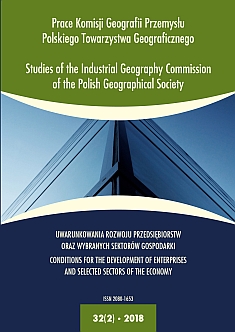Arctic Tourism Development with Regard to Legal Regulations and Environmental Protection
DOI:
https://doi.org/10.24917/20801653.322.20Keywords:
arctic tourism, environmental protection, global changes, legal regulationsAbstract
Arctic tourism develops very quickly and requires both changing of legal regulations and consid-ering environmental issues. The developing branch of services (significantly tourism) has became an important sector in the shaping of the budget of numerous countries worldwide. World-wide climate changes provide new possibilities of visiting remote countries with severe climate conditions. Global warming is particularly intense in the Arctic, where mean temperatures have recently risen twice as fast as in the rest of the world. A comprehensive set of regulations was recently developed to protect the wilderness of Arctic environment from the negative impact of tourism. The purpose of the paper is to present legal and organizational regulations connected with organization of tourist trips in the Arctic, based on the example of Svalbard area, American Arctic and Russian Arctic. There are described particularly legal regulations that concern cruise operators. These issues have been described based on literature studies, analysis of legal regulations and statistical data. The time range of the study is about 20 years. Also discussed are challenges of tourism as seen in the Northwest Passage, a historical challenge for many sailors and Russian Arctic tourism development. The issues of economic benefits, environmental protection and connections between tourism and climate conditions are presented. There is also a focus on weather enabling tourism in the Arctic. It can be said that new possibilities of visiting remote places with severe climate conditions (e.g. Arctic region) are opening due to global changes. It occurs mainly due to the reduced sea ice cover for longer periods of time, which facilitates tourist access and extends visitor seasons. It has been assumed that global climate change may lead to a shift of tourism demand to higher latitudes, creating additional opportunities for tourism in northern regions.
Downloads
Metrics
References
Burkart, A.J., Medlik, S. (1974). Tourism. Past, Present and Future. London: Heinemann.
Bystrowska, M., Dolnicki, P. (2015). The impact of endogenous factors on diversification of tourism space in the Arctic. Current Issues of Tourism Research, 5, 36–44.
Duhaime, G., Rasmussen, R.O., Comtois, R. (1997). Sustainable Development in the North: Local Initiatives vs Megaprojects. Proceedings of the Second Circumpolar Social Science Ph.D. Network Conference, held in Aguanish, Québec, GETIC, Sainte-Foy, Presses de l’Université Laval.
Evenset, A., Christensen, N. (2011). Environmental impacts of expedition cruise traffic around Svalbard. Association of Arctic Expedition Cruise Operators.
Gómez Martín, M.B. (2006). Climate potential and tourist demand in Catalonia (Spain) during the summer season. Climate Research, 32, 75−87.
Intergovernmental Panel on Climate Change (2007). Climate change 2007: synthesis report. Contribution of working groups I, II and III to the fourth assessment report of the Intergovernmental Panel on Climate Change. Core Writing Team. In: R.K. Pachauri, A. Reisinger (Eds.). IPCC, Geneva, Switzerland.
Jacobsen, J., Denstadli, J., Lohmann, M., Førland, E. (2011). Tourist weather preferences in Europe’s Arctic. Climate Research, 50, 31–42.
Jørgensen, F. (2013). Regulation of tourism and prevention of accidents CMERA Workshop. Tromsø, 6–7 Nov, AECO.
Pagnan, J. (2003). The impact of climate change on Arctic tourism: A preliminary review. World Tourism Organization First International Conference on Climate Change and Tourism. Djerba, Tunisia, 9–11.04.
Panasiuk, A. (2006). Informacja turystyczna. Szczecin: Wydawnictwo Naukowe Uniwersytetu Szczecińskiego.
Przybylak, R. (2002). Changes in seasonal and annual high-frequency air temperature variability in the Arctic from 1951–1990. International Journal of Climatology, 22.
Rosenberg, M. (2007). The Northwest Passage may allow ship travel across Northern Canada, http://geography.about.com/od/specificplacesofinterest/a/northwestpassag.htm
Snyder, J. (2007). Tourism in the Polar Regions. The Sustainability Challenge. UNEP.
Stewart, E.J., Dawson, J., Howell, S.E.L., Johnston, M.E., Pearce, T., Lemelin, H. (2013). Local-level responses to sea ice change and cruise tourism in Arctic Canada’s Northwest Passage. Polar Geography, 36(1–2).
Svalbard Environmental Protection Act, Act of June 15, 2001, No. 79, Norway. (www.sysselmannen.svalbard.no/laws_enviro_en.htm)
Wallace, J. (2006). Taking the Northwest Passage. Experts stress the importance of answering Arctic sovereignty questions sooner rather than later. Canadian Geographic, 3–4.
www.acia.uaf.edu/pages/scientific.html
www.aeco.no
www.biodiversity.ru/coastlearn/tourism
www. barentsobserver.com/en/sections/politics/russian-arctic-national-park-novaya-zemlya
www.cbc.ca/news/canada/north/arctic-tourism-heating-up-as-northwest-passage-melts
www.climate.weather.gc.ca
www.commerce.alaska.gov
www.ipcc.ch
www.sysselmannen.svalbard.no/travel
www.world-tourism.org
www.wto.org
Downloads
Published
How to Cite
Issue
Section
License
Articles are published under the terms of the Creative Commons License (CC BY-ND 4.0; Attribution– NoDerivs).

